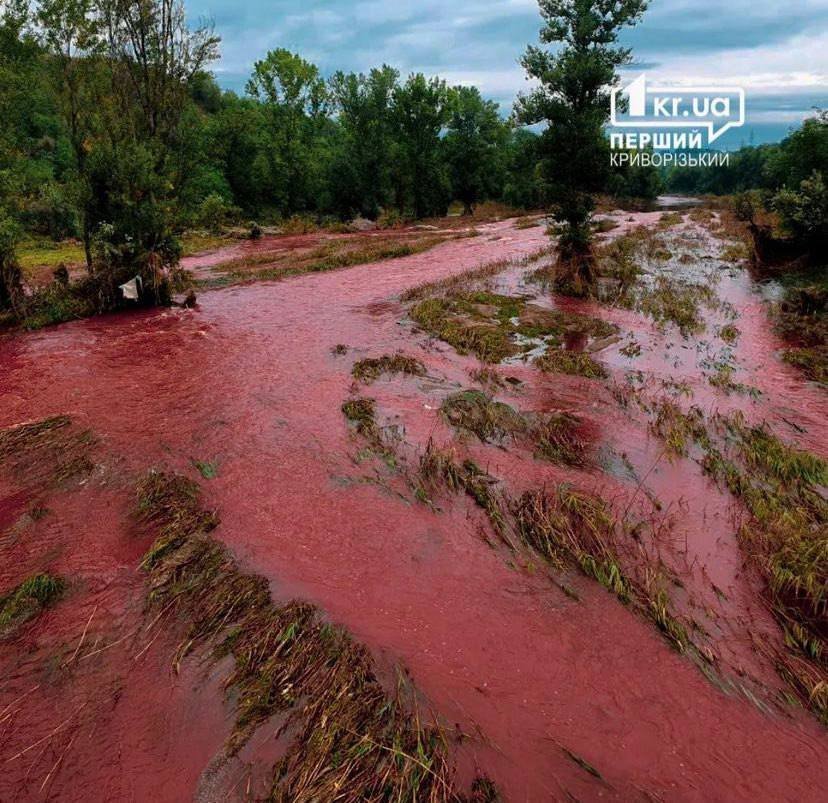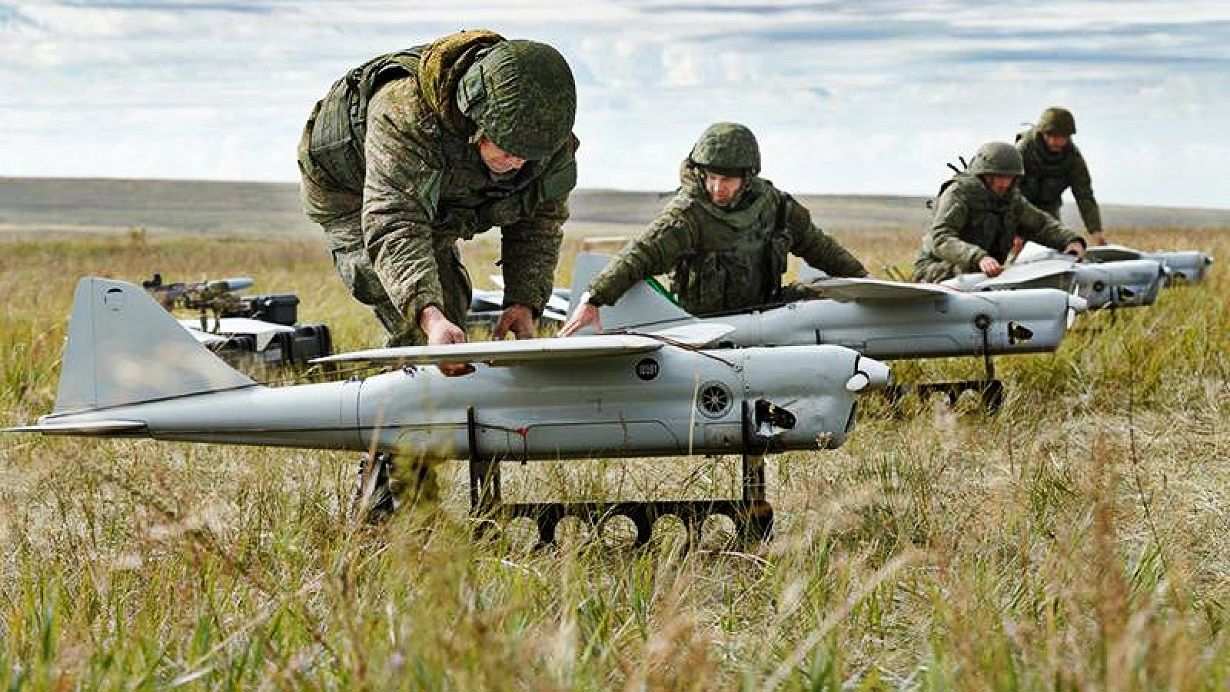Chilling images have surfaced on social media of the Inhulets River turning blood red a day after Russian forces struck the Karachunivske reservoir in Kryvyi Rih, the largest city in central Ukraine.
Aliens Hovering Over Ukraine? Kyiv’s Main Observatory Says County’s Airspace Visited By Numerous UFOs With No Military Link
Russian Su-35 Fighters ‘Challenge’ Rafales, Eurofighter Typhoons As Turkey Struggles To Get Approval For F-16s From The US
Eight Russian cruise missiles struck Kryvyi Rih, the birthplace of President Volodymyr Zelensky, on September 14-15, resulting in the destruction of the water pumping station, which led the Inhulets River to break through a dam on September 15.
“Kryvyi Rih again came under enemy fire. The Russians directed their missiles at critical infrastructure. There is serious destruction of hydraulic facilities,” Valentyn Reznichenko, Head of the Dnipropetrovsk Regional Military Administration, said in a Telegram post on September 16.
Water in the Inhulets river turned red after Russian missiles damaged the dam near Kryvyi Rih
?https://t.co/breeHLjGFH pic.twitter.com/1l7jMM1QTq
— Euromaidan Press (@EuromaidanPress) September 16, 2022
The head of Kryvyi Rih’s military administration, Oleksandr Vilkul, explained that there was nothing to worry about the reddening of the water, as it was caused by the entry of one of the components of iron ore into it.

Vilkul noted that the red color in the water is produced by a component of iron ore called ‘hematite,’ explaining that in the city of Kryvyi Rih, there are red sparrows and red dogs as well.
“It’s okay – after a few days after washing, the water will be the usual color. Hematite is an inorganic constituent of Fe2O3, iron oxide. And there are no problems,” Vilkul said.
“Vile Russian Act” – Zelensky
Kryvyi Rih is home to 650,000 people, and the residents of the city in many areas have been evacuated after the strikes on the Karachunivske reservoir by the Russian Kinzhal and Iskander cruise missiles that are said to have increased the water level of Inhulets by 2.5 meters.
President Zelensky condemned the attack on Kryvyi Rih in very strong words, referring to it as a ‘vile Russian act.’ “Everything is being done to eliminate the consequences of yet another vile Russian act,” Zelensky said in a video address on September 15.
Furthermore, switching to speak in Russian, Zelensky said, “Your missile attacks today, targeting Kryvyi Rih, the dam of the Karachunivske reservoir, the objects that have no military value at all, in fact hitting hundreds of thousands of ordinary civilians, is another reason why Russia will lose.… You are cowards waging war against civilians; scoundrels who, having fled the battlefield, are trying to do harm from somewhere far away.”
While the Ukrainian foreign minister, Dmytro Kuleba, described the attack as “a war crime and an act of terror.”
Russian missile strike on Kryvyi Rih hydraulic structures is a war crime and an act of terror. Beaten by Ukrainian army on the battlefield, Russian cowards are now at war with our critical infrastructure and civilians. Russia is a terrorist state and must be recognized as such.
— Dmytro Kuleba (@DmytroKuleba) September 14, 2022
“Beaten by [the] Ukrainian army on the battlefield, Russian cowards are now at war with our critical infrastructure and civilians. Russia is a terrorist state and must be recognized as such,” Kuleba wrote on Twitter.
Bitter Ukraine, Russia Conflict
However, the assertion that the Karachunivske reservoir had no ‘military value at all’ does not seem entirely accurate. Russian military experts have explained that the purpose behind striking the Karachunivske reservoir was to slow the down the Ukrainian offensive in Kherson.
Ukrainian forces have secured the bridgehead – a strong position inside enemy territory from which they can advance or attack. But to deploy its troops and equipment at this bridgehead, Ukrainian forces have to cross the Inhulets river.
It appears Russian cruise missile strike today hit and damaged a water reservoir dam in Kryvyi Rih in Ukraine (possibly around here 47.906624,33.282471 ). Multiple reports of water levels in Inhulets River in Kryvyi Rih rising quickly. https://t.co/pWzhk5Ed3K
— D. mojavensis ?? ?? Ї (@Dmojavensis) September 14, 2022
The increase in water levels of the river following the Russian missile strike on the Karachunivske reservoir has blocked half of the Ukrainian crossing points.
“Crossing the Ingulets is everything,” military expert Yury Podolyaka wrote on his Telegram channel on September 14.
Podolyaka explained that “the water retention system in the area of the Karachun reservoir was damaged, due to which the water level in Ingulets, through which the AFU [Armed Forces of Ukraine] crossing was built south of Davydov Brod, rose sharply.

“And… for now, the Armed Forces of Ukraine do not have a normal crossing to the Andreevsky bridgehead. Not for long, of course, but right now, she is gone !!!” Podolyaka said.
Even the Ukrainian forces are known to have employed similar tactics to slow the Russian advance in the eastern Donbas region of Ukraine.
In May, the People’s Militia of the LPR (Luhansk People’s Republic) accused the Ukrainian armed forces of destroying the gateway on the Mironovsky reservoir to slow the Russian advance across the Luhan River toward Svetlodarsk in the Bakhmut Region of Donetsk Oblast.
#NewsMap
Looks like the Ukrainian defense line north of Debaltseve partially collapsed.
Russian invasion forces captured the city of #Myronivsky (formerly 8.000 inhabitants), meaning, Russia also captured the Myronivsky Power Station.
Now, the Luhan provides a natural barrier. pic.twitter.com/ud9mLrh4fl— Julian Röpcke?? (@JulianRoepcke) May 23, 2022
“Video confirmation of the terrorist act of the VFU at the Mironovsky reservoir. Under the threat of flooding of a number of settlements of the LNR,” said Lieutenant Colonel Andrey Marochko, the People’s Militia of the LPR, in his telegram channel on May 14.
The servicemen of the Armed Forces of Ukraine, retreating, blew up the lock at the Mironovsky reservoir in the LPR. Several settlements of the republic may be under water. pic.twitter.com/PYV9k3Oyem
— bigrussianshop?? (@bigrussianshop) May 14, 2022
Prior to that, in April, there was an explosion of a dam at the Oskol reservoir in the Kharkiv region, which spilled the water from the Oskul river into the Seversky Donets River, causing the latter to overflow its banks.
A video of the consequences of the explosion of the dam of the Oskol reservoir in the Kharkiv region.
The Seversky Donets River overflows its banks and floods
Svyatogorsk. pic.twitter.com/VjlkgALV0j— Ipster???? (@Ipster_FI) April 2, 2022
Both Russia and Ukraine accused each other of blowing up the dam, but during the month of April, it was the Russian army that was advancing across the Seversky Donets river to capture Izium in Kharkiv, meaning the flooding of the river could have benefitted Ukraine.
- Contact the author at tanmaykadam700@gmail.com
- Follow EurAsian Times on Google News




